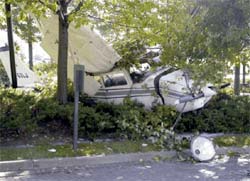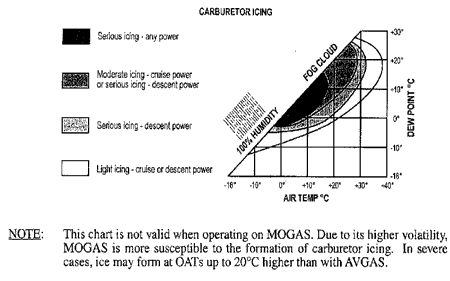Engine Power Loss and Forced Landing
Toronto Airways Limited
Cessna 172N C-GZLJ
Toronto/Buttonville Municipal Airport 2 nm SSE
Toronto, Ontario
The Transportation Safety Board of Canada (TSB) investigated this occurrence for the purpose of advancing transportation safety. It is not the function of the Board to assign fault or determine civil or criminal liability. This report is not created for use in the context of legal, disciplinary or other proceedings. See Ownership and use of content. Masculine pronouns and position titles may be used to signify all genders to comply with the Canadian Transportation Accident Investigation and Safety Board Act (S.C. 1989, c. 3).
Summary
At approximately 1300 eastern daylight time, the Toronto Airways Limited Cessna 172N aircraft (registration C-GZLJ, serial number 17269614) departed from the Toronto/Buttonville Municipal Airport on a sightseeing flight over Toronto, Ontario. The pilot and three passengers were on board. Before take-off, an engine ground run revealed no anomalies. The pilot applied full power for the take-off, climbed to an altitude of 2000 feet above sea level (1300 to 1400 feet above ground), levelled off, and selected the Toronto/City Centre Airport tower radio frequency. Shortly after that, the engine (Lycoming O-320-H2AD) began to lose power. The pilot informed the tower of the power loss and the intention to return to the Toronto/Buttonville Municipal Airport.
Trying to regain power, the pilot ensured that full throttle was selected, checked the positions of the primer and magnetos, and switched fuel tanks. When these attempts were unsuccessful, the pilot selected the carburettor heat to the hot position, observed a further decrease in engine power, and reset the carburettor heat to the cold position. The engine was not producing enough power to maintain level flight and return to the airport, so the pilot searched for a suitable location for a forced landing. The aircraft was over a densely populated area, and the only suitable clearing was surrounded with trees and nearby buildings. The engine lost power on final approach. The pilot selected the flaps to the full-down position, overflew the clearing, and stalled the aircraft into the trees. The aircraft was substantially damaged and one passenger received minor injuries.
Factual information
The pilot was qualified for the flight, held a valid commercial pilot licence, and had approximately 1200 hours' total flying time, of which about 500 hours were on the Cessna 172 aircraft.
Records show that the aircraft was maintained in accordance with current regulations. A review of the documentation revealed no outstanding defects before the flight.
Aviation routine weather reports were obtained for the Toronto/Buttonville Municipal Airport for 1300 eastern daylight time,Footnote 1 and showed wind 090° T at 6 knots, visibility 12 statute miles, a broken cloud layer at 25 000 feet, temperature 23°C (73.4°F), dew point 14°C (57.2°F), and altimeter setting 30.21.
While on approach to the clearing, it appeared to the pilot that the ground was on a downslope. During the pilot's flight training, it was shown that landing on soft ground with a downslope may result in the landing gear digging in and the aircraft flipping over. Aware of this possibility, the pilot chose to stall the aircraft into the trees to reduce impact forces and injuries.
No discrepancies were noted during the wreckage examination, which concentrated on determining the cause of the engine power loss. The following checks were made:
- external examination of the engine;
- compression of cylinders;
- condition and operation of spark plugs and associated wiring harnesses;
- intake and exhaust valves condition; and
- security and operation of carburettor and its heat controls.
Fuel samples were taken from the left-wing fuel tank, the carburettor bowl, and gascolator bowl. The samples were free of contaminants and displayed a light blue colour, indicative of aviation grade 100 low lead (LL) fuel. The carburettor and gascolator fuel screens were also free of contaminants. The carburettor was removed from the engine and disassembled, but revealed no anomalies that would have affected its operation.
The fuel supply line, from the firewall to the gascolator bowl fitting, was disconnected and drained for sampling. The sample smelled the same as aviation fuel, but it was a straw colour. Two fuel samples, one blue and one straw-coloured, were sent to the TSB Engineering Laboratory for analysis (LP 115/2003) to determine the origin of the yellow colour. The blue sample met the requirements of 100 LL aviation fuel specification, but the lead content of the yellow sample was 16.01 per cent more than the maximum permitted.
The sample was examined by gas chromatography-mass spectrometry to pinpoint its composition. It was identical in composition to grade 100 LL aviation fuel, but contained 1 per cent of 2-ethyl-1-hexanol (also known as iso-octyl alcohol or as 2-ethylhexyl alcohol) and about 0.6 per cent of decanedioic acid bis (2-ethylhexyl) ester. Both components are foreign to aviation fuel.
The 2-ethyl-1-hexanol component is normally used as a plasticizer for polyvinyl chloride (PVC) resins and in some proprietary additives for unleaded automobile gasoline. The decandioic acid is an oily liquid, sometimes described as pale straw in colour. Some of its uses are as an ingredient in lubricants for military jet engine oil and in grease. It is also used in hydraulic and metal working fluids.
Although the straw-coloured sample did not meet the requirements for aviation grade 100 LL fuel, the low concentration within the fuel would not have affected the operation of the engine. Further research determined that the owner/operator does not apply additives to the fuel, and the origin of these components was undetermined.
The carburettor icing graph (Appendix A) was referenced as a guideline to find out if icing conditions existed for the flight. By intersecting the temperature and dew point values on the graph, it was determined that moderate icing conditions existed at the time of the flight. It was also found that the operator's maintenance personnel encountered carburettor icing during full-power ground runs with similar aircraft.
Analysis
The aircraft was serviceable for this flight; nothing mechanical was found that would explain the loss of engine power. The aircraft was flying in conditions where carburettor ice was a real possibility, and the engine symptoms were like those associated with carburettor icing. Therefore, it is concluded that the loss of power was related to carburettor ice.
Monitoring the engine operation and applying carburettor heat when ice formation is suspected are imperative to reduce the likelihood of an engine power loss during flight. The application of carburettor heat is a normal procedure for pilots when engine power begins to degrade. However, time required for the carburettor heat to be effective and the initial degradation of engine performance following the application of carburettor heat may not be fully understood.
When carburettor heat is selected on, engine power is reduced because of the lower volumetric efficiency of warmer air, which results in a richer mixture. As the ice melts, it is ingested into the engine intake as water, increasing engine roughness and further reducing power. To .compensate for the power loss, the throttle must be increased, if possible, and the mixture leaned appropriately. It requires time for the warmer air to eliminate the ice formation and allow the engine to regain power.
Weather was a factor in this occurrence, because the ambient temperature and dew point values were in the range where moderate carburettor icing could occur. After the engine began to lose power, the pilot applied carburettor heat as per normal procedures, but did not allow enough time for the warmer air to clear any ice that had formed. Further loss of power after carburettor heat application should have been anticipated. Engine performance continued to degrade as more ice accumulated.
Although the straw-coloured fuel found in the fuel line to the gascolator bowl did not meet the specification of grade 100 LL aviation fuel, the concentration of foreign components in the fuel was not enough to affect engine operation. Furthermore, clean and contaminant-free 100 LL aviation fuel was found between this fuel and the engine, and would have been supplying the engine.
Findings
Findings as to causes and contributing factors
- Ambient temperature and dew point conditions during the flight most likely resulted in carburettor icing, which caused the engine to lose power.
- When the engine began to lose power, the pilot applied carburettor heat, but noted it resulted in a further decrease in engine power and selected the carburetor heat off. The heat was not on long enough to remove any ice.
Other findings
- The pilot was unable to find a suitable landing area and intentionally stalled the aircraft into the trees, resulting in substantial damage to the aircraft.
This report concludes the Transportation Safety Board's investigation into this occurrence. Consequently, the Board authorized the release of this report on .
Appendices

